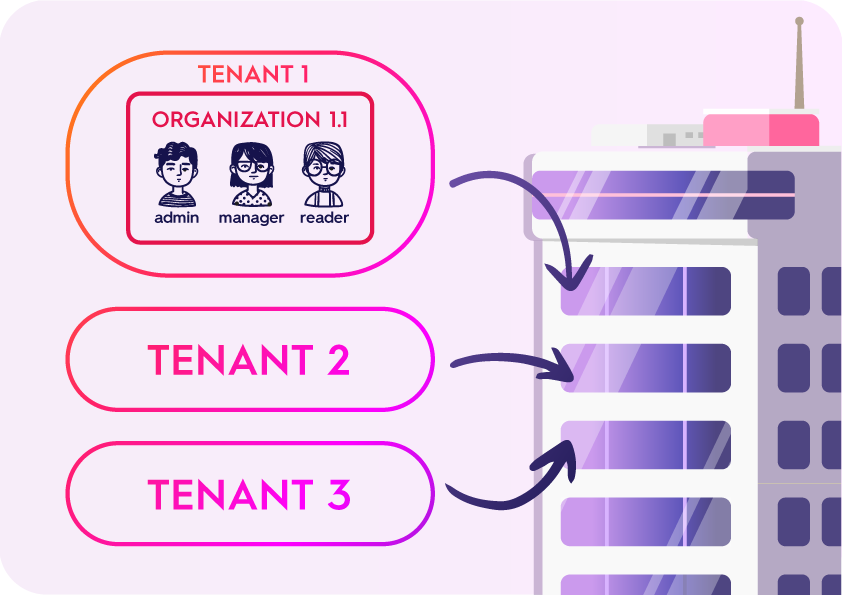Everything you need to know about Multitenancy

Marketing
Given the explosive popularity of cloud services in recent years, we are now increasingly seeing organizations of all sizes seeking to utilize Software as a Service applications. While SaaS is generally an ideal deployment option for businesses seeking a pre-configured platform, many such applications are solely equipped with a single-tenant architecture, thus significantly limiting the addressed use cases. Therefore, if your organization is looking for a SaaS provider with enhanced scalability, a high level of customization and the opportunity for a Business-to-Business (B2B) use case, we strongly recommend looking into the concept of multitenancy.
This article will discuss multitenancy's definition and its benefits over a single-tenant SaaS architecture.
What is multitenancy?
In a nutshell, multi-tenant architecture is a cloud-oriented ecosystem that uses scalable, available, and resilient architecture, allowing one SaaS application to support multiple tenants. It has the primary purpose of sharing a database and codebase across all clients with a similar data structure while their data remains logically separated.
At its core, multitenancy is conceptually similar to an apartment complex. Within this context, the apartment building represents a single SaaS environment that hosts multiple tenants (customers).

The business providing the multi-tenant SaaS application takes on the role of the construction enterprise and landlord. In this example, this buisness is called Apolon. Apolon’s SaaS solution serves three clients: Miho, Posh, and Cyane; the tenants of the “apartment.” While the tenants share their computational, networking, and storage resources, their personal data is isolated and invisible to each other; reminiscent of the fact that real-life apartment renters do not have unsolicited access to other flats either.
If you view multiple apartments of the same complex, you will likely find that despite their differences in furnishings and decorations, each flat shares the same fundamental architecture. The concept of a multi-tenant SaaS environment functions according to a similar scheme: While Apolon’s core application functionality is reused for each of its customers, they can customize the certain aspects of their experience, such as login according to their respective organization’s attributes (f.e. colors, logo, selected secondary login-factors, etc.).
To regulate access to specific aspects of the application, tenants generally assign specific roles to each member of their organization. Thus, each member of the organization automatically receives the corresponding authorization that their role entails.
The Benefits
While the previous chapter explained the structure of a multi-tenant architecture as a metaphor for an apartment complex, within that same context, a single-tenant architecture would be best represented by tract housing. With these real-life parallels of these two technical concepts established, the differences they hold over each other become increasingly evident. The following paragraphs list the most significant benefits multitenancy has over single-tenant architecture.
Shared resources and bases - Easier implementation
In the case of tract housing, the lots (SaaS) are constructed by the same enterprise (the business providing the single-tenant SaaS) and are, therefore, akin to apartments, identical in their fundamental architecture. However, unlike households within the same complex, the tenants of tract houses do not share any commodities: The environment only serves a single customer. For this reason, each tenant of a single-tenant architecture requires dedicated computing, network, and storage resources, as well as data- and codebases that would need to be individually integrated into each environment.
SaaS applications with a multitenant architecture, such as ZITADEL, include a single codebase along with a code repository with a few branches. By not having to individually implement every branch of code to a potentially large number of tenants, the deployment process is easily carried out with the help of just one command (one-click-deployment).
Freehand maintenance
Similar to the maintenance of an apartment complex, in which the association maintains all expected amenities, the SaaS vendor is responsible for several aspects of database upkeep. To lift some weight off the provider’s shoulders, the multi-tenant server is regularly launching automated upgrades and optimizations, thus preserving the performance and agility of the application.
Lower prices
The shared commodities and responsibilities provided by a multi-tenant architecture also result in lower fees for the SaaS vendor: Instead of paying for multiple deployment and maintenance processes individually provided to every tenant, the cost of the environment is shared. As a result of these low and predictable ongoing costs, the application can generally be sold for a set subscription price.
Higher scalability and easy customization
Most multi-tenant SaaS applications provide tenants the ability to scale on demand. Furthermore, since every additional user receives access to the same basic software, the process of scaling has far fewer infrastructure implications than within a single-tenant solution.
Multitenancy also allows for a facile, coding-free customization process. For example, ZITADEL’s SaaS solution allows each tenant to personalize their login flow by determining the Federation (Azure AD, Google Workspace, etc.), password policies, colors, logos, domains and login multi-factors.
Support for B2B
One of the most common use cases of multitenancy is within a Business to Business (B2B) context. Due to its formerly mentioned advantages, we recommend a SaaS with a multi-tenant architecture to B2B vendors that wish to provide isolation and branding for their clients' organizations without wasting money, time and resources.
In Conclusion
The resource-sharing capabilities of multitenant services allow them to function with lower infrastructure and maintenance costs while simultaneously providing higher operational effectiveness. Despite the environment’s shared commodities, the affordable multi-tenant SaaS solution of ZITADEL ensures each tenant complete privacy regarding their data, a highly customizable login flow and on-demand scaling.
To lean more about ZITADEL, feel free to contact us anytime on our ZITADEL Discord Server. Alternatively, you can reach us on our Twitter, Linkedin or Github pages or on our Website.